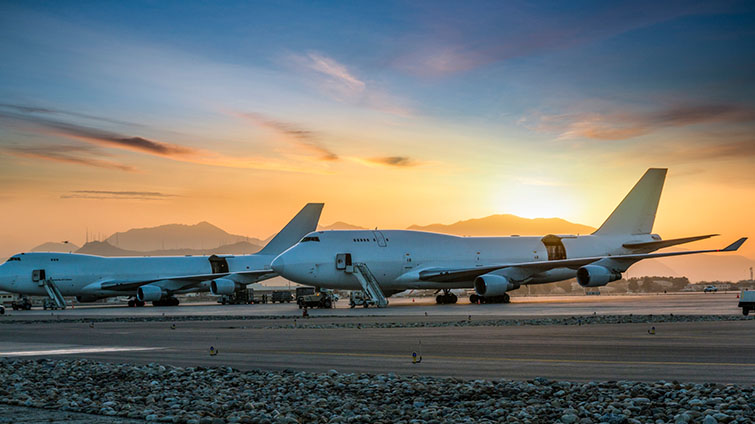Many regions face capacity constraints, creating delays

Asia
Air freight out of Asia is entering a volatile period as shippers react to key policy deadlines. The 90-day lowering of U.S. tariffs on Chinese-made goods is set to expire in August, prompting Chinese exporters to frontload shipments. Lower reciprocal tariffs on goods from other nations are set to expire on July 9, 2025. This production ramp-up is expected to drive a sharp demand surge through late June and into July, particularly on Trans-Pacific Eastbound (TPEB) lanes.
Complicating matters, on May 28, 2025, a court ruled the U.S. president cannot impose tariffs by declaring a national emergency. This ruling applied to the 10% reciprocal tariffs now in place on imports from most countries as well as the 20% tariffs related to drug trafficking imposed on goods made in China.
A federal appeals court quickly stayed the decision, and the tariffs remain in effect while the appeals process unfolds. Arguments are due to the court by June 9, 2025. Because the case could end up in the U.S. Supreme Court, it’s unclear whether a resolution will come before the tariff reductions expire in July and August.
The elimination of the de minimis rule in May—which had allowed duty-free ecommerce imports under $800—has significantly slowed volumes from small parcel shippers. Airlines scaled back capacity in May but are now cautiously adding it back as demand recovers.
This balancing act is expected to tighten available space and push rates higher throughout June, especially for non-priority shipments. Quarter-end demand and tariff deadlines will likely create bottlenecks for last-minute bookings.
Shippers should consider booking space two to three weeks in advance and explore alternate routes through Southeast Asia, when possible, to adapt quickly to shifting conditions.
Export rates from India are experiencing a gradual downward trend, a pattern expected to persist through June, with space readily available for shipments to both the U.S. and EU markets. Demand continues to be supported by pharmaceuticals and perishable goods. No significant capacity additions are anticipated for June, although ecommerce volumes are projected to grow steadily in the coming months. Delhi Airport remains the primary hub, offering the most capacity and connectivity across all sectors.
Europe
Air freight demand across Europe is expected to remain stable through June. Capacity is largely balanced, particularly on outbound lanes to North America and Asia. However, niche industries like pharmaceuticals and aerospace may face pockets of rate hikes and transit constraints, especially for temperature controlled or dangerous cargo.
No major tariff or regulatory shifts are currently expected to disrupt flows, though European shippers remain cautious due to ongoing macroeconomic headwinds and geopolitical tensions near eastern Europe.
The Europe–Asia market has shown slight softening, due to manufacturers pausing orders during the recent Dragon Boat Festival holiday. As more capacity returns to the market, rates could become more competitive, particularly on Frankfurt routes, where demand remains high.
LATAM
Air freight flows from Latin America are shifting with the season, creating pockets of capacity pressure and rate volatility. Perishable volumes out of South America to the United States and Europe remain strong, but northbound capacity is constrained, especially from Brazil and Chile. Carriers are prioritizing high-yield exports, making backhaul space competitive.
Intra-LATAM air trade continues to lag pre-pandemic levels, with limited service to smaller regional airports.
Book early for perishable exports, and where feasible, explore multimode solutions to navigate northbound capacity constraints.
North America
Capacity remains constrained due to lagging returns from Asia and subdued ecommerce volumes. Some U.S. gateways, particularly on the West Coast, are beginning to see more consistent service restoration, but space is expected to stay tight as demand builds. Exporters may face equipment imbalances in inland locations due to reduced backhaul flows.
Amid evolving customs rules and continued tariff uncertainty, shippers are weighing mode shifts to keep time-critical cargo moving.
Monitor equipment availability closely—particularly at inland rail ramps—and consider shifting urgent shipments to air to stay ahead of expected third quarter ocean capacity constraints.
South Asia, Middle East, Africa (SAMA)
Southeast Asia remains relatively stable compared to the China market. However, the 90-day reduction of U.S. reciprocal tariffs is set to end July 9, 2025, likely driving increased demand in June as shippers rush to move cargo before potential policy changes.
The convergence of quarter-end shipping surges with the tariff deadline may place significant pressure on air freight capacity across all Asia origins, impacting both rates and transit times through early summer.
Oceania
Shippers in Oceania continue to battle service delays, particularly for Asia-bound cargo. Congestion at Asian transshipment hubs, such as Singapore and Hong Kong, is causing extended lead times. Labor negotiations at major Australian terminals are also a looming risk, potentially spilling into air cargo operations if disruptions spread.
Capacity to Europe and North America remains stable but tight, with higher costs on last-minute bookings due to limited carrier flexibility.
Allow extra lead time for intra-Asia segments and build contingency into routing plans for time-sensitive shipments.